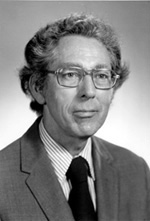Harold E. Moore, Jr.
(1917 - 1980)

The Cornell Connection: Moore joined the staff of the L.H. Bailey Hortorium, Cornell University, in 1948 and eventually became the Hortorium's third Director, serving from 1960 until 1969.
Harold E. Moore, Jr. was born on July 7, 1917 in Winthrop, Massachusetts. He attended Massachusetts State College and graduated in 1939. He received his doctorate degree in 1942 from Harvard University. From 1942 until 1946, Moore served in the Army. After returning to Harvard, Moore was offered a position by L. H. Bailey to work at the Bailey Hortorium. He joined the staff in 1948 and eventually became the Hortorium's third Director, serving from 1960 until 1969.
After developing an interest in palms during the early 1950's, Moore travelled around the world to observe palms in their natural habitat and collect specimens. He made repeated trips to the the islands of the Pacific in his study of the systematics of palms. Moore's expertise in writing resulted in many articles about palms, as well as articles on other plants of interest to him. His most notable palm work was The Major Groups of Palms and Their Distribution published in 1973. This was preliminary to a much larger work on palms, to be called Genera Palmarum, but his death in 1980 left it unfinished. Genera Palmarum was later completed in 1987 by Dr. Natalie Uhl of the Hortorium and Dr. John Dransfield of the Royal Botanic Gardens at Kew.
In addition to his palm endeavors, H. E. Moore was also the editor of the journal Principes from 1957 until 1980. Principes (now known as Palms) is a scientific journal published by The International Palm Society. Published four times a year, the journal required a substantial amount of Moore's time to maintain the high standards he had set. As editor, Moore was able to critique and encourage others interested in the study of palms.
For further information please see:
Bates, David M. 1982. Harold E. Moore, Jr. - A Remembrance, Principes 26 (1), pp. 3-8.
H. E. Moore, Jr. Memorial Volume. 1982. Various articles throughout volume. Principes 26 (1-4).
